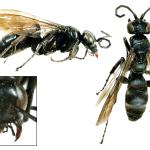Anoplius approximatus (Smith, 1877), A. bifidus (Morawitz, 1891), A. distinguendus (Morawitz, 1891), A. haereticus (Tournier, 1889), A. banksi (Dreisbach, 1950);
Widespread but local in England and Wales, with one old record from central Scotland and one recent record from Moray. There are two old records from Ireland, from where it may well be under-recorded.
Overseas, found throughout Europe, North Africa and the near East to Mongolia (Wolf, 1972).
Not listed in either Shirt (1987) or Falk (1991) but the shortage of records suggests that the status of this species should be reviewed.
Day, 1988 is the standard work for identifying British Pompilidae. Wiśniowski, B., 2009 is also useful.
Males and females run on wet stones exposed in gravelly stream beds, and fly between them and the banks (Day, 1988). Also found at the margins of pools in sand and gravel pits, where it may be locally common (M Edwards, pers. comm.).
June to September in Britain. There may be two generations per year in the north German lowlands (perhaps also in Britain) when the wasps overwinter in the last larval stage and males appear from the end of May. They often break into cells to mate with newly emerged females (Haeseler, 1993).
Spiders of the family Lycosidae.
Multiple cells are excavated beneath stones and stocked with spiders which live under other stones (Bonelli, 1973; Day, 1988). In the sand pits mentioned above, females prey on spiders that run over the surface of the very shallow water at the edges of the pools. In north-west Germany, this species has been found nesting between paving stones in urban areas, with nests as deep as 9 cm and with up to seven cells. One spider, caught after the cell has been excavated, is placed in each cell. Females may rob each other's cells, and fighting may occur (Haeseler, 1993).
No information available.
No information available.
1998


